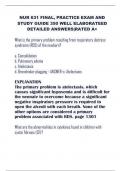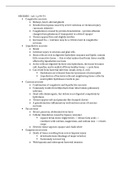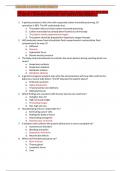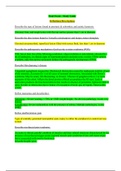Nur 631 final 3 - Study guides, Class notes & Summaries
Looking for the best study guides, study notes and summaries about Nur 631 final 3? On this page you'll find 26 study documents about Nur 631 final 3.
Page 3 out of 26 results
Sort by

-
NUR 631 FINAL, PRACTICE EXAM AND STUDY GUIDE 350 WELL ELABORATEED DETAILED ANSWERS|RATED A+
- Exam (elaborations) • 121 pages • 2024
-
- $14.41
- + learn more
NUR 631 FINAL, PRACTICE EXAM AND STUDY GUIDE 350 WELL ELABORATEED DETAILED ANSWERS|RATED A+ What is the primary problem resulting from respiratory distress syndrome (RDS) of the newborn? a. Consolidation b. Pulmonary edema c. Atelectasis d. Bronchiolar plugging - ANSWER-c. Atelectasis EXPLANATION The primary problem is atelectasis, which causes significant hypoxemia and is difficult for the neonate to overcome because a significant negative inspiratory pressure is required t...

-
NUR 631 - WEEK 3 QUIZ FINAL REVIEW.
- Exam (elaborations) • 14 pages • 2021
-
- $13.49
- + learn more
NUR 631 - WEEK 3 QUIZ FINAL REVIEW. / NUR 631 - WEEK 3 QUIZ FINAL REVIEW. NECROSIS – tab 1, p.90-91 Coagulative necrosis o Kidneys, heart, adrenal glands o Results from hpoxia caused by severe ischemia or chemical injury (mercuric chloride) o Coagulation is caused by protein denaturation ->protein albumin changes from gelatinous & transparent to a firm & opaque o Tissues appear firm and slightly swollen o Increased Ca++ (calcium) may be a critical event in coagulative necro...

-
NUR-631 Final Exam Questions & Answers with Rationales 2024/2025
- Exam (elaborations) • 55 pages • 2024
-
- $11.49
- + learn more
NUR-631 Final Exam Questions & Answers with Rationales 2024/2025 Removal of part of the liver leads to the remaining liver cells undergoing compensatory - ANSWER-Compensatory hyperplasia is an adaptive mechanism that enables certain organs to regenerate. For example, the removal of part of the liver leads to hyperplasia of the remaining liver cells (hepatocytes) to compensate for the loss. Which of the following statements best describes Raynaud disease? a. An inflammatory disorder of sma...

-
NUR 631 ACCURATE 2023/2024 WINTER QTR FINAL EXAM.COMPLETE TEST WITH ACCURATELY ANSWERED QUESTIONS.100% VERIFIED EXAM GRADED A+
- Exam (elaborations) • 7 pages • 2024
-
- $11.99
- + learn more
NUR 631 ACCURATE 2023/2024 WINTER QTR FINAL EXAM.COMPLETE TEST WITH ACCURATELY ANSWERED QUESTIONS.100% VERIFIED EXAM GRADED A+ 1. A patient presents to the clinic with suspected carbon monoxide poisoning, O2 saturation is 99%. The NP understands that: a. The patient does not have carbon monoxide poisoning b. Carbon monoxide has already been flushed out of the body c. The patient needs supplemental oxygen d. The patient should be prepared for hyperbaric oxygen therapy 2. H2O molecules mo...

-
Grand Canyon University:NUR 631 Final Exam Study Guide (Fall Session)
- Study guide • 14 pages • 2020
-
- $18.98
- 1x sold
- + learn more
(NUR 631 Final Exam Study Guide) NUR 631 Final Exam Study Guide (Fall Session) Definitions/Descriptions Question: Describe the type of lesions found in psoriasis & seborrheic and actinic keratosis. Question: Describe the skin lesions found in Varicella (chickenpox) and herpes zoster (shingles). Question: Describe the pathogenetic mechanism of polycystic ovarian syndrome (POS). Question: Describe Hirschsprung’s disease. Question: Define marasmus and kwashiorkor. Question: Define deafferentatio...

-
NUR 631 Topic 16 Final Exam Chart
- Exam (elaborations) • 38 pages • 2021
-
- $20.99
- + learn more
NUR 631 Topic 16 Final Exam Chart Angina Pectoris Myocardial Infarction Pancreatitis Cholecystitis Appendicitis Peritonitis Nephrolithiasis Ovarian Cysts Gout Osteoarthritis Osteoporosis Rheumatoid Arthritis Sciatica Osetomyelitis Cellulitis ADH Aldosterone ANP BNP Hyponatremia Hypernatremia Diabetes Insipidus SIADH Potassium (3.5-5.0)/ ECF, Hypokalemia <3.5 Hyperkalemia >5.5 Bicarb (HCO-3) (24-28) CO2 (35-45) pH <7.4=acidic >7.4= akaline Anemia ...

Did you know that on average a seller on Stuvia earns $82 per month selling study resources? Hmm, hint, hint. Discover all about earning on Stuvia


